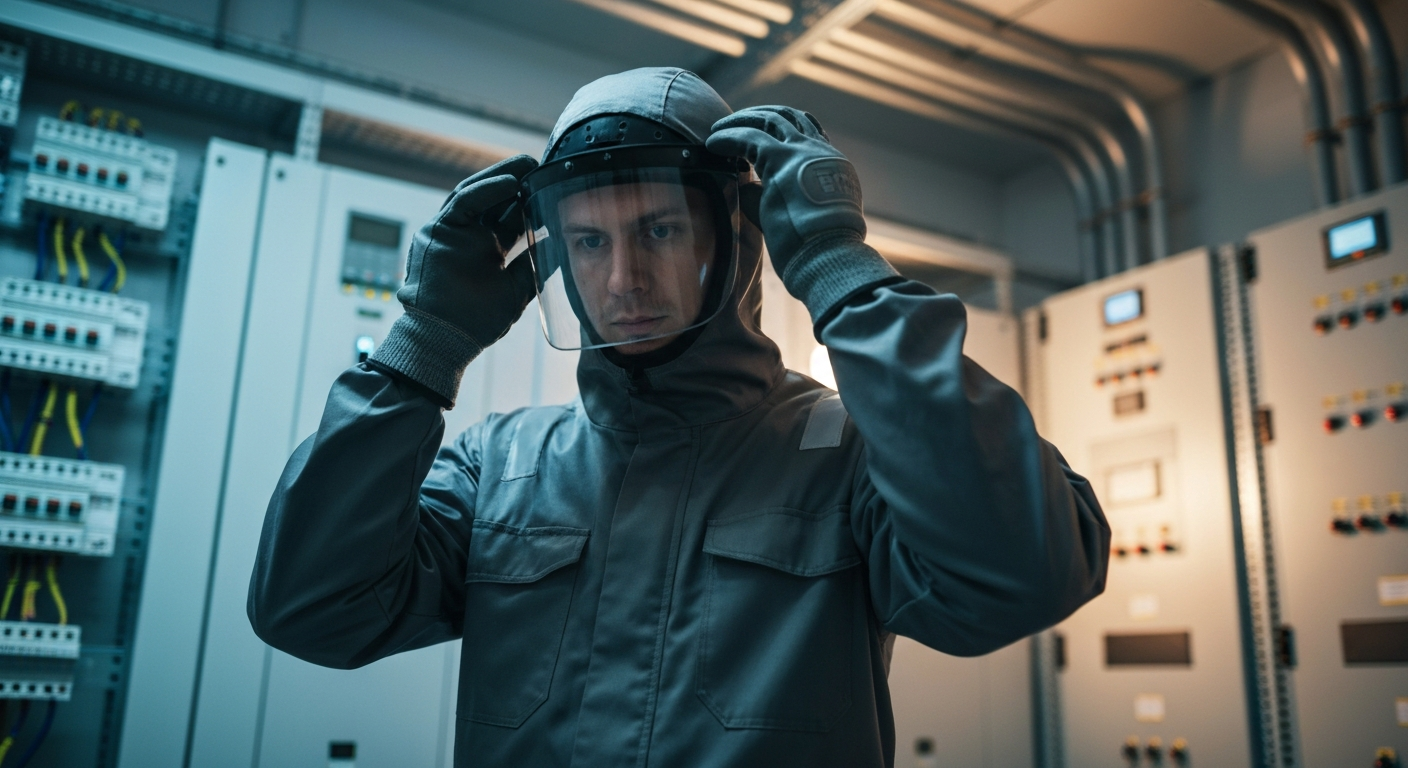
NFPA 70E 2024: Arc Flash PPE Categories Explained
This article dives into the core concepts of arc flash PPE categories as defined in the latest standard, helping you navigate the requirements and reinforce your commitment to a safer work environment for you and your crew.
First Things First: PPE is the Last Line of Defense
Before we even talk about suits and gloves, the 2024 NFPA 70E reinforces a foundational concept: the hierarchy of risk controls. This safety philosophy prioritizes eliminating the hazard altogether. PPE, while essential, is the final step you take when the hazard cannot be removed. The hierarchy, from most to least effective, is:
- Elimination: The most effective method. De-energize the equipment completely. An electrically safe work condition is always the goal.
- Substitution: Replace a higher-hazard process with a lower-hazard one.
- Engineering Controls: Use features like remote racking or remote switching to distance yourself from the hazard.
- Awareness: Warning labels and signs alert personnel to danger.
- Administrative Controls: This includes thorough job safety planning and obtaining an energized electrical work permit when necessary.
- Personal Protective Equipment (PPE): Your last line of defense when working on or near energized equipment.
A robust electrical safety program, a requirement heavily emphasized in the 2024 standard, should be built around this hierarchy.
How to Select Your Arc Flash PPE: Two Approved Methods
When an electrically safe work condition can’t be established, you must protect yourself. NFPA 70E outlines two methods for selecting the appropriate arc-rated clothing and other PPE: the incident energy analysis method and the PPE category method.
1. Incident Energy Analysis Method
This is the more detailed and precise approach. An incident energy analysis is a calculation performed as part of a comprehensive arc flash risk assessment, typically by an engineer. The analysis determines the exact amount of thermal energy a worker could be exposed to at a specific working distance, measured in calories per square centimeter (cal/cm²). Your PPE’s arc rating must meet or exceed this calculated value. This method provides the most accurate level of protection for a specific task on a specific piece of equipment.
2. PPE Category Method
When an incident energy analysis isn’t available, NFPA 70E provides tables, such as Table 130.7(C)(15)(a) for AC systems and Table 130.7(C)(15)(b) for DC systems, that allow a qualified person to determine a PPE Category (1-4) for specific tasks and equipment conditions. This method is more generalized but provides a proven, standardized level of protection. To use this method, you must ensure the equipment’s fault-clearing time and available fault current are within the limits specified in the tables.
The 4 Arc Flash PPE Categories (Formerly HRC)
The 2024 standard continues to use the four-category system, which simplifies PPE selection based on the task’s risk level. If you’ve been in the trade for a while, you’ll remember these as Hazard Risk Categories (HRC), but they are now simply called PPE Categories. It’s a semantic change, but the principles remain the same.
- PPE Category 1 (Minimum Arc Rating: 4 cal/cm²): This is the lowest level of arc-rated protection, typically for low-risk tasks like infrared thermography or operating circuit breakers with covers on. It generally requires an arc-rated long-sleeve shirt and pants or coveralls. Per the NFPA 70E standard, other required items include a hard hat, safety glasses or goggles, hearing protection, heavy-duty leather gloves, and leather footwear.
- PPE Category 2 (Minimum Arc Rating: 8 cal/cm²): This category covers more moderate-risk tasks. It often requires an arc-rated long-sleeve shirt and pants or coveralls, plus an arc-rated balaclava and an arc-rated faceshield, or an arc flash suit hood. Due to advancements in fabric technology, many manufacturers now offer comfortable CAT 2 gear, leading many companies to standardize on it for both CAT 1 and CAT 2 tasks.
- PPE Category 3 (Minimum Arc Rating: 25 cal/cm²): Entering high-risk territory, this category often involves work like racking breakers on unenclosed switchgear. It requires a full arc flash suit system, including a jacket, pants or coveralls, and a full hood.
- PPE Category 4 (Minimum Arc Rating: 40 cal/cm²): For the highest-risk tasks on energized equipment, CAT 4 provides the maximum level of protection commonly available. It requires a full, multi-layered arc flash suit with a minimum rating of 40 cal/cm², along with insulated gloves and other necessary protective equipment.
It’s important to remember that these are minimums. The arc rating of your selected gear must always meet or exceed the potential hazard level determined by your arc flash risk assessment.
Defining Your Workspace: Shock Protection Boundaries
Beyond arc flash, the risk of electric shock remains a primary concern. NFPA 70E defines specific shock protection boundaries that every qualified person must know.
- Limited Approach Boundary: This is the furthest boundary. An unqualified person may not cross this line unless escorted by a qualified person.
- Restricted Approach Boundary: This is closer to the energized parts. Only a qualified person wearing appropriate shock protection PPE (like rubber insulating gloves) may cross this boundary. An energized electrical work permit is typically required to perform work within this space.
The 2024 edition clarifies that the boundary for establishing an electrically safe work condition is the limited approach boundary, while the trigger for an energized work permit is crossing the restricted approach boundary.
Key Updates and Practical Takeaways
The 2024 NFPA 70E brings several refinements aimed at improving clarity and safety:
- Glove Protectors: The standard has replaced the term “leather protectors” with simply “protectors” for gloves worn over rubber insulating gloves, opening the door for newer, advanced materials that offer equivalent protection.
- Qualified Person: There’s continued emphasis that being a qualified person isn’t just about holding a license; it means you have demonstrated skill and knowledge for the specific task and equipment you’re working on and have received safety training to identify and avoid the associated hazards.
- OSHA Alignment: NFPA 70E is a voluntary standard, but it’s considered the industry benchmark for best practices. OSHA often uses it as a reference when enforcing its own mandatory standards, like OSHA 1910 Subpart S, which governs electrical safety in general industry.
- PPE Maintenance and Inspection: An arc flash suit or arc-rated clothing is an investment in your life. The standard underscores the importance of regular PPE maintenance and inspection. Any clothing with holes, tears, or contamination that can’t be removed must be taken out of service.
Related Resources
- How have NFPA 70E 2024 battery safety requirements changed?
- Can I use 14 AWG copper-clad aluminum conductors in my LED lighting circuits?
Stay Current, Stay Safe
The electrical industry is constantly evolving, with new technologies and refined safety standards. Keeping up with changes to core standards like NFPA 70E is not just a professional obligation—it’s a critical part of protecting your most valuable asset: yourself. Continuing education is key to ensuring you are always working with the most current safety knowledge.
Ready to sharpen your skills and stay on top of the latest code changes and safety protocols? Browse our courses to find the continuing education you need to power your career safely and effectively.
Disclaimer: The information provided in this educational content has been prepared with care to reflect current regulatory requirements for continuing education. However, licensing rules and regulations can vary by state and are subject to change. While we strive for accuracy, ExpertCE cannot guarantee that all details are complete or up to date at the time of reading. For the most current and authoritative information, always refer directly to your state’s official licensing board or regulatory agency.



